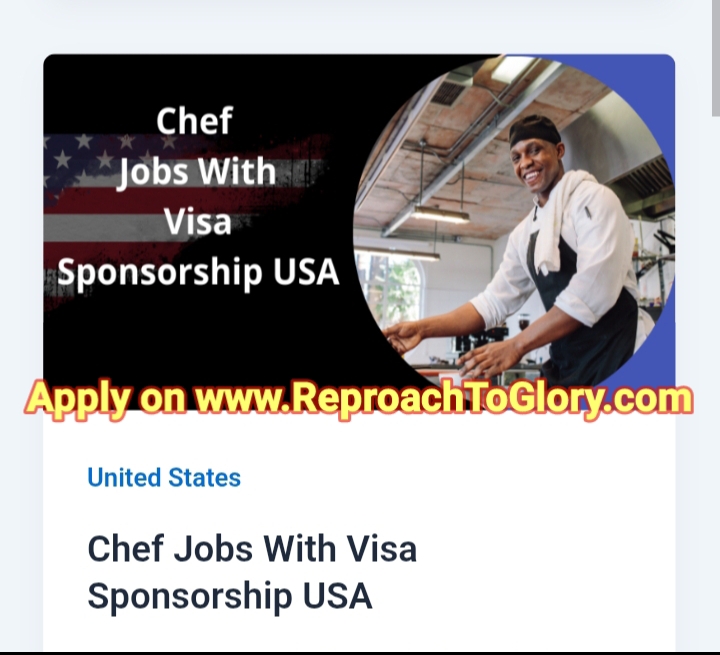The hospitality industry in the United States is a culinary melting pot, drawing influences and talent from around the globe. American diners crave diverse flavors—from high-end sushi bars and avant-garde pastry shops to cozy bistros serving authentic European cuisine.
As a result, the country’s food scene needs skilled chefs more than ever, and many businesses are ready to sponsor a visa to attract the right talent. If you’re an international chef looking to capitalize on this demand, this guide will walk you through the different types of chef positions, common U.S. visa options, requirements, typical salary ranges, and the key steps to land a job.
Chef jobs with visa sponsorship USA
- Types of Chef Jobs in the USA
Chefs in America can find a host of opportunities suited to various specialties, backgrounds, and experience levels. Here are some of the most common roles:
Executive Chef (Head Chef)
Duties: Overseeing all aspects of the kitchen, from menu design and budgeting to staff supervision and quality control.
Setting: Fine-dining establishments, upscale hotels, high-end restaurants.
Compensation: Can range from $60,000 up to $100,000+ annually, depending on the size and prestige of the venue.
Sous Chef
Role: Acts as the executive chef’s right-hand person, helping supervise daily operations, train kitchen staff, and manage food prep.
Importance: Often steps up when the head chef is absent.
Common Salary: $45,000 to $70,000 per year.
Pastry Chef
Focus: Specializes in baking and dessert creation—bread, cakes, pastries, chocolates, and more.
Where to Find: Fine-dining restaurants, bakeries, luxury hotels, specialty dessert shops.
Earning Potential: Typically $40,000 to $65,000 annually, with some high-end pastry chefs surpassing $80,000.
Line Cook (Station Chef)
Primary Tasks: Prepare specific dishes or ingredients at different kitchen stations (sauté, grill, fry, etc.).
Career Launchpad: Perfect for chefs starting out, offering broad exposure to the pace and rigors of a U.S. commercial kitchen.
Hourly Wages: Often $14 to $18, translating to $29,000–$37,000 yearly.
Private or Personal Chef
Clients: Celebrities, high-net-worth families, corporate executives.
Unique Perks: May receive lodging, travel, and other benefits in addition to salary.
Pay Range: $70,000 to $150,000 annually for experienced professionals.
Sushi Chef
Expertise: Skilled in Japanese cuisine, particularly sushi preparation, fish butchery, and presentation.
Demand: High in metropolitan areas with upscale Japanese restaurants or niche sushi bars.
Salary: Typically $40,000–$70,000, though master sushi chefs can exceed $80,000.
Catering Chef
Functions: Plans and prepares meals for large-scale events—weddings, corporate gatherings, galas.
Advantages: Opportunities to showcase varied menus and specialized culinary talents.
Annual Pay: $40,000–$70,000.
Cruise Ship Chef
Environment: Floating hotels catering to an international clientele, requiring multiple cuisine styles.
Conditions: Employers often provide room and board; salaries range $35,000–$70,000, depending on your position.
- Why Pursue a Chef Job With Visa Sponsorship
Securing a U.S.-based chef role that includes visa sponsorship can yield multiple benefits, including:
Competitive Salaries
Earnings range from $30,000 for entry-level cooks to over $100,000 for top executive chefs, dependent on experience, location, and the caliber of the establishment.
Additionally, you may earn bonuses, tips, or profit sharing, especially in high-end restaurants.
Significant Career Growth
The U.S. culinary market is vast, featuring everything from Michelin-starred fine-dining venues to large-scale catering companies.
Gaining experience in a demanding American kitchen, known for its innovation and global focus, can accelerate your progress toward roles like head chef or restaurant owner.
Cultural Exchange and Networking
American kitchens host workers from diverse backgrounds, offering you a chance to learn about different cuisines and cooking philosophies.
You’ll encounter regional American ingredients and customs, broadening your repertoire and enabling you to innovate once you return home or move onto future endeavors.
High Demand and Job Security
As tourism grows and dining culture evolves, skilled chefs remain sought after. Even in less cosmopolitan areas, there’s a steady shortage of well-trained culinary professionals.
Enhanced Standard of Living
The USA consistently ranks high on global quality-of-life indices. You’ll have access to modern amenities, decent infrastructure, and a generally safe environment.
Pathway to Permanent Residency
H-2B or J-1 visas might open the door to more permanent routes, like the EB-3 or even the O-1 visa (for extraordinary ability).
Over time, with the right sponsorship and track record, you may transition to a green card or citizenship.
- Visa Options for Chefs Seeking Work in the USA
Navigating U.S. immigration laws can be complex. Below are the chief visa pathways for foreign chefs:
H-2B (Temporary Non-Agricultural Worker)
Scope: For short-term or seasonal chef roles in hospitality, such as resorts or theme parks in peak season.
Duration: Typically valid up to 10 months; can sometimes be renewed in yearly increments up to 3 years.
Requirements: Employer must prove a shortage of available U.S. workers and file a petition with the Department of Labor.
H-1B (Specialty Occupations)
Who Qualifies: Generally for roles requiring a bachelor’s degree or specialized expertise.
Chef Relevance: In rare cases, an advanced or unique skill set (e.g., molecular gastronomy, specialized pastry techniques) might justify an H-1B.
Constraints: Capped annually and more often used by tech or finance professionals, not the typical chef route.
EB-3 (Employment-Based Green Card)
Benefit: Offers permanent residency under “Skilled or Unskilled” categories.
Process: Employer must secure labor certification, proving they cannot fill the position locally.
Timeline: Can take multiple years, but a direct path to a green card.
J-1 (Exchange Visitor Program)
Focus: Cultural and educational exchange programs, including culinary internships and trainee stints.
Ideal For: Recent culinary school graduates or mid-level chefs wanting exposure to the U.S. kitchen environment.
Duration: Often 12–18 months, sometimes extending to 24 for certain specialized training.
O-1 (Extraordinary Ability)
Who’s Eligible: Chefs with major achievements, awards, media recognition, or critical acclaim in gastronomic circles.
Higher Bar: Must prove you’re among the top in your field with substantial international acclaim.
- Requirements and Eligibility
Exact standards differ by employer and visa category, but some general criteria for chef jobs with visa sponsorship in the USA include:
Formal Culinary Training
Certificates in commercial cookery or a related culinary diploma. Some employers accept equivalent on-the-job training if you can show relevant experience.
Work Experience
Most sponsors prefer 2–5 years of industry experience. High-volume kitchens, fine dining, or specialized cuisine expertise can significantly strengthen your application.
English Proficiency
Typically measured through standardized tests (like IELTS or TOEFL). Sufficient language skills are vital for following health codes, dealing with English-speaking co-workers, and communicating with customers.
Health and Safety Knowledge
Familiarity with U.S. food safety and hygiene standards. Some employers require ServeSafe or other certifications.
Clean Criminal Record
Visa applications often necessitate background checks. Past convictions might complicate or preclude approval.
Employer Sponsorship
Must secure a firm job offer from a U.S. employer who will file the necessary labor certification or petition on your behalf.
- Typical Salaries and Benefits
While pay scales vary by region, here’s a rough breakdown:
Executive Chef
$60,000–$100,000/year, occasionally higher at premier venues.
Sous Chef
$45,000–$70,000/year. Room to grow into an executive chef role.
Chef de Partie (Line Cook)
Average: $15–$22/hour ($31,200–$45,760/year). Mid-level stations or specialized tasks can command higher pay.
Pastry Chef
$40,000–$65,000/year. Luxury hotels or top patisseries can push beyond $80,000.
Private/Personal Chef
$70,000–$150,000. Additional perks like housing, travel, or performance bonuses might apply.
Cruise Ship Chef
$35,000–$70,000/year plus free lodging and meals. Opportunities for rapid promotion.
Additional Benefits:
Health insurance (medical, dental, vision)
401(k) or other retirement savings plans
Paid sick leave, vacation time
Meal allowances or staff meals
Tip-sharing (in some front-of-house-involved roles)
- Finding and Applying for Visa-Sponsored Chef Jobs
Pinpoint Potential Employers
Hotels & Resorts: Chains like Marriott, Hilton, Hyatt often hire foreign chefs.
Cruise Lines: Carnival, Royal Caribbean, Norwegian, and others.
Restaurants: Upscale groups or Michelin-starred establishments that prize international expertise.
Catering Companies: Large-scale event caterers needing diverse culinary skills for special events.
From the complete guide, you will have access to Top hospitality employers that will offer you visa sponsorship jobs in USA as a Chef.
Specialized agencies focus on placing chefs from overseas and streamline the visa process, though ensure you deal with reputable ones.
Prepare a Strong Application
Resume: Emphasize culinary experience, specializations (e.g., patisserie, sushi, farm-to-table), and notable achievements (awards, media features).
Cover Letter: Articulate your interest in U.S. culinary culture, highlight your adaptability, and mention your readiness to handle visa requirements.
References: Letters from ex-employers or instructors vouching for your reliability, creativity, and leadership can sway hiring decisions.
Interview Preparation
Expect a possible cooking demo or a portfolio showcasing your plating style if applying for higher-level positions.
For phone or Skype calls, be ready to discuss your professional path, technical proficiency, and how you’ll adapt to a new work environment.
Securing the Visa
After a successful interview, the employer files a petition (e.g., H-2B). You then apply for the corresponding visa in your home country.
Provide all requested documents (passport, job contract, sponsor letter, proof of relevant training and experience).
Attend an in-person consular interview and wait for your visa approval.
- Tips for Success as a Foreign Chef in the USA
Learn the Local Regulations
U.S. kitchens follow rigorous safety and hygiene standards. Familiarize yourself with the FDA’s Food Code, allergen protocols, and labeling requirements.
Demonstrate Flexibility
Kitchens can have long hours, weekend shifts, or holiday demands.
Adaptable chefs are quickly valued and often promoted.
Pursue Ongoing Education
Take advantage of culinary workshops or short courses offered by your employer. An extra certificate in pastry arts or modern cooking methods could boost your career prospects.
Build a Professional Network
Attend chef conferences, gastronomic festivals, or local food events to meet potential mentors or future employers.
Consider joining chef associations or industry groups to stay current on trends and job openings.
Maintain Good Workplace Relationships
Be collaborative. From dishwasher to manager, every coworker helps maintain the restaurant’s reputation.
Positive references can pave the way to better-paying roles or additional sponsorship.
Conclusion
Chef jobs with visa sponsorship in the USA remain a tantalizing avenue for talented international cooks to hone their craft, earn a competitive wage, and explore a diverse cultural environment. Whether you aspire to manage a five-star restaurant’s entire culinary staff or master the art of high-volume cooking on a cruise ship, the American market has a slot for you. The key lies in zeroing in on the right role, fulfilling visa criteria, and confidently presenting your qualifications.
Though the visa process may initially feel daunting, each step—targeting suitable visa categories, assembling your credentials, approaching potential sponsors—puts you closer to a richly rewarding career. Opportunities for advancement abound in America’s hospitality industry, from promotions and raises to the possibility of opening your own restaurant down the line.
Ultimately, with the right mix of credentials, determination, and culinary passion, you can land a chef job in the U.S. that not only enriches your repertoire but also sets you on a journey that could evolve into permanent residency or entrepreneurship. So sharpen those knives, refine your signature dishes, and start exploring. Your next big culinary chapter may be just a plane ride away.
To get the complete guide and proper mentorship, you will pay a one time fee of $100 but if you join today; you will get 70% discount and you will pay $30 today instead of $100.
CHECK ALL AVAILABLE VISA SPONSORED JOBS.
To make the PAYMENT today and also for more INFORMATION; kindly SEND an EMAIL to reproachtoglory@gmail.com or reproachtoglory@yahoo.com and our ADMINS will be AVAILABLE at your SERVICE.
a BRIGHTER FUTURE is PRESENT on REPROACH TO GLORY INTERNATIONAL EMPIRE.


